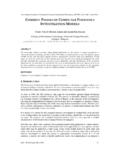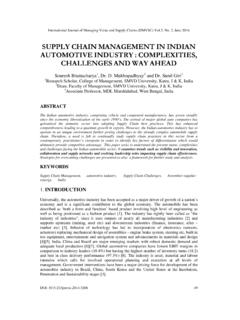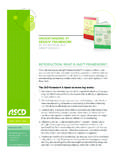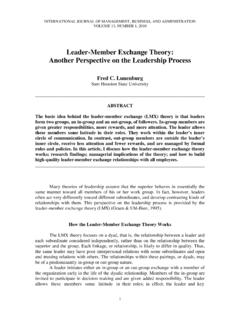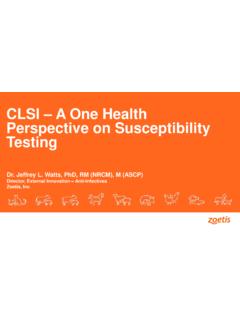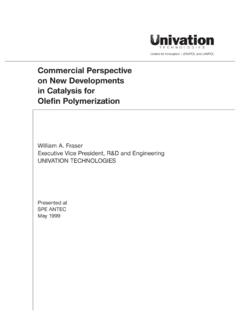Transcription of International Journal of Managing Value and …
1 International Journal of Managing Value and Supply Chains (IJMVSC) , No. 1, March 2013 DOI: OFRICE ININDIA:ARICEPROCESSINGCOMPANY SPERSPECTIVEV ishal Sharma1, Dr. Sunil Giri2and Siddharth Shankar Rai31 Research Scholar, College of Management, SMVD University, Katra, J &K, College of Management, SMVD University, Katra, J & K, Scholar, College of Management, SMVD University, Katra, J&K, paper dealswith the practical issues which exist inthe supply chain of rice. The paper discussesvarious issues related to collaboration at downstream end of the supply chain, inventory management,demand consolidation andinventory reduction.
2 While dealing with the supply chain issue it alsogetsintodeal with the various procurement issues and finally a re-designed supply chain model has been Consolidation, Collaboration, Milk Run Routing System, Inventory Management, Supply is the basicgrain consumed as a food in India which is found in almost every Indian is the most common grain and the most common food in India, however, India is not only a bigconsumer of rice but also it is the second largest producer of rice in the world after holds the largestagriculturelandfor paddy productionin the world. In 2009total arable landfor paddyin the world is158300068 hectarewith the total production of685240469tonnes ofpaddy,out of which41850000hectare ofthe area is held by India only, which produced133700000tonnes of paddy just second after196681170tonnes by leads in terms ofthe land holding, while the production is led by China.
3 The smallest paddy production and arableland both is claimed by the Russian Federation with912970tonnes and177500hectaresrespectivelywith second lowest figure of Iran(Source: Directorate of Economics and Statistics,Department of Agriculture and Cooperation).A time series statistics by from 1949 to 2010 shows, thatIndia over a period oftime has grown in the total agriculture land and the production of thecontinuous growth for area, production and the yield of rice, however in recent years it has showna littlebit of decline, which should be considered seriously and the necessary measures must betakento keep it again on the growing track.
4 But over the period of time it has shown a growingtrend which we can interpret that India has grown in terms of rice producingland from hectare and million tonnes of rice production with an yield of 771kg per hectare in1949-50 million hectare agriculture land for rice, million tonnes of produced riceand 2125 kg per hectare yield in the year is not only known for its production, but it is also one of the biggest consumers of rice inthe world Figure1shows its domestic consumption while making it clear that most of its totalrice supply is consumed in India.
5 With the help ofa time series data from 1960 2012, thestatistics of the figure shows thatin year 1960 the domestic consumption of rice was35473 International Journal of Managing Value and Supply Chains (IJMVSC) Vol. 4, No. 1, March 201326thousand metric tonne on the supply of38040thousand metric tonnes rice, which increased in theyear 2012 after a long growing trend to95250thousand metric tonnes of domestic consumptionon a supply of124100thousand metric tonnes of rice.(Source: )Figure 1:Total supply and consumption of rice in India from 1960-2012 The economics of rice in Indiaincludingproduction, supply, consumption and yield, along withthe agriculture land for paddy farming has continuously shown a growing trend for a period oftime, however,with lots of fluctuations and a growing trend it has shown adecliningtrend in all these areasin the recenttime which is the time of global change.
6 And it canbe interpreted as a negative sign if it is about the coping up of the rice industry with and Pandey[1]while studying the two villages in India observe the slowagricultural growth of rice as a major issue and emphasise on the new opportunities on increasingthe productivity and speeding up the agricultural [2]find in a studythat production of rice in India is questionable on economic andecological the concern of study and it can beeitherdue to thetechnological obsolescence, the production, distribution, andthe issues of market, or all of theseissues.
7 All these issuesform it as aconcernof the supply chainmanagement,which isdefined asa philosophy[3]whichstudythe entire flow of material and goods throughout the channel in anintegrated way, starting from supplier to the end is an integration of three or moreestablishments whose activities are interlinked together directly with a purpose to flow theproducts, services, finances and information either in upstream or downstream way between theend customer and the source[4].Onecan say that for proper functioning of the rice sector in theagriculture industry, and regaining its upward growing trend it is necessary to resolve its supplychain problems, and hence a complete study of the rice supply chain management and itsreengineering is OF THERICEINDUSTRYAs riceisthe basic grain of daily consumption in India, it alwayshasthe significant demandwhich shows a seasonal growing trendespeciallyat the time of festivals and during the seasons ofcultural events.
8 To identify the appropriate demand and meet them properly in a profitable way isprimary concern of rice supply proper supply chain management framework is veryessential for efficient sourcing, processing, distribution, and retailing and hence meetingthecustomer demands without facingasituation of lost and business of rice hasbeen one of the most traditional and major concerns of Indian Economy, but still no propersupply chain framework for it has been developed, whichvery oftencauses unfulfilled demands, International Journal of Managing Value and Supply Chains (IJMVSC) Vol.
9 4, No. 1, March 201327stock outs and overstocking, and distribution issues. The main reasonbehindnot getting properattention is,rice industry has always been treated as the subject ofAgriculturalEconomics andnever became able to portray itself as a topicof supply chain of its operations arevery traditional which need to be reformed if it has to gain competitive advantage in the era traditionally followedbasic framework forrice supply chain management generally followsthemultistage supply chain system including: Farmers as the basic supplier of paddy, middlemen oragents, rice processing industries, distribution agents, and retailers.
10 As the interlinked upstreamand downstream the long supply chain process many activities take place at everystagewhich affect the function of next stage and requires it to co-operate in the understand the detailed process, the study describes a detailed supply chainframework, as shown in Figure2 ,which explains the complete supply chain activities currentlybeing practiced in the rice process clearly explainswhere the supply chain requiresthe intermediaries and where it is sourced and distributed directly to the next major stage of the rice supply chain is held by the paddy farmerswho supply paddy to the riceprocessing companies, which is supplied both directly and through intermediaries, depending onthe type of farmers and their farmers may be categorised in two types as.
